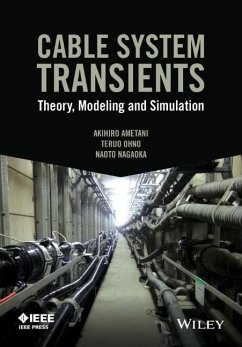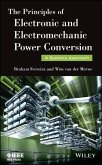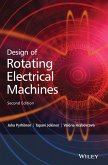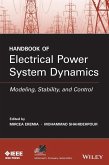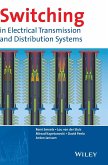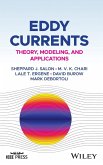- Gebundenes Buch
- Merkliste
- Auf die Merkliste
- Bewerten Bewerten
- Teilen
- Produkt teilen
- Produkterinnerung
- Produkterinnerung
A systematic and comprehensive introduction to electromagnetic transient in cable systems, written by the internationally renowned pioneer in this field * Presents a systematic and comprehensive introduction to electromagnetic transient in cable systems * Written by the internationally renowned pioneer in the field * Thorough coverage of the state of the art on the topic, presented in a well-organized, logical style, from fundamentals and practical applications * A companion website is available
Andere Kunden interessierten sich auch für
![The Principles of Electronic and Electromechanic Power Conversion The Principles of Electronic and Electromechanic Power Conversion]() Braham FerreiraThe Principles of Electronic and Electromechanic Power Conversion106,99 €
Braham FerreiraThe Principles of Electronic and Electromechanic Power Conversion106,99 €![Design Rotating Electrical Mac Design Rotating Electrical Mac]() Juha PyrhonenDesign Rotating Electrical Mac165,99 €
Juha PyrhonenDesign Rotating Electrical Mac165,99 €![Smart Grid Using Big Data Analytics Smart Grid Using Big Data Analytics]() Robert C. QiuSmart Grid Using Big Data Analytics94,99 €
Robert C. QiuSmart Grid Using Big Data Analytics94,99 €![Power System Restoration Power System Restoration]() M. M. Adibi (Hrsg.)Power System Restoration247,99 €
M. M. Adibi (Hrsg.)Power System Restoration247,99 €![Electrical Power System Dynami Electrical Power System Dynami]() Electrical Power System Dynami165,99 €
Electrical Power System Dynami165,99 €![Switching in Electrical Transmission and Distribution Systems Switching in Electrical Transmission and Distribution Systems]() René SmeetsSwitching in Electrical Transmission and Distribution Systems141,99 €
René SmeetsSwitching in Electrical Transmission and Distribution Systems141,99 €![Eddy Currents Eddy Currents]() Sheppard J. SalonEddy Currents88,99 €
Sheppard J. SalonEddy Currents88,99 €-
-
-
A systematic and comprehensive introduction to electromagnetic transient in cable systems, written by the internationally renowned pioneer in this field
* Presents a systematic and comprehensive introduction to electromagnetic transient in cable systems
* Written by the internationally renowned pioneer in the field
* Thorough coverage of the state of the art on the topic, presented in a well-organized, logical style, from fundamentals and practical applications
* A companion website is available
Hinweis: Dieser Artikel kann nur an eine deutsche Lieferadresse ausgeliefert werden.
* Presents a systematic and comprehensive introduction to electromagnetic transient in cable systems
* Written by the internationally renowned pioneer in the field
* Thorough coverage of the state of the art on the topic, presented in a well-organized, logical style, from fundamentals and practical applications
* A companion website is available
Hinweis: Dieser Artikel kann nur an eine deutsche Lieferadresse ausgeliefert werden.
Produktdetails
- Produktdetails
- Verlag: Wiley & Sons
- 1. Auflage
- Seitenzahl: 550
- Erscheinungstermin: 10. August 2015
- Englisch
- Abmessung: 249mm x 172mm x 27mm
- Gewicht: 770g
- ISBN-13: 9781118702123
- ISBN-10: 1118702123
- Artikelnr.: 40551769
- Herstellerkennzeichnung
- Libri GmbH
- Europaallee 1
- 36244 Bad Hersfeld
- gpsr@libri.de
- Verlag: Wiley & Sons
- 1. Auflage
- Seitenzahl: 550
- Erscheinungstermin: 10. August 2015
- Englisch
- Abmessung: 249mm x 172mm x 27mm
- Gewicht: 770g
- ISBN-13: 9781118702123
- ISBN-10: 1118702123
- Artikelnr.: 40551769
- Herstellerkennzeichnung
- Libri GmbH
- Europaallee 1
- 36244 Bad Hersfeld
- gpsr@libri.de
Akihiro Ametani, Doshisha University, Japan Teruo Ohno, Tokyo Electric Power Company, Japan Naoto Nagaoka, Doshisha University, Japan
About the Authors xi Preface xiii Acknowledgements xv 1 Various Cables Used in Practice 1 Teruo Ohno 1.1 Introduction 1 1.2 Land Cables 3 1.2.1 Introduction 3 1.2.2 XLPE Cables 4 1.2.3 SCOF Cables 9 1.2.4 HPOF Cables 10 1.3 Submarine Cables 11 1.3.1 Introduction 11 1.3.2 HVAC Submarine Cables 11 1.3.3 HVDC Submarine Cables 12 1.4 Laying Configurations 13 1.4.1 Burial Condition 13 1.4.2 Sheath Bonding 14 References 19 2 Impedance and Admittance Formulas 21 Akihiro Ametani 2.1 Single-core Coaxial Cable (SC Cable) 22 2.1.1 Impedance 22 2.1.2 Potential Coefficient 25 2.2 Pipe-enclosed Type Cable (PT Cable) 27 2.2.1 Impedance 27 2.2.2 Potential Coefficient 29 2.3 Arbitrary Cross-section Conductor 31 2.3.1 Equivalent Cylindrical Conductor 31 2.3.2 Examples 32 2.4 Semiconducting Layer Impedance 35 2.4.1 Derivation of Impedance 35 2.4.2 Impedance of Two-layered Conductor 38 2.4.3 Discussion of the Impedance Formula 38 2.4.4 Admittance of Semiconducting Layer 40 2.4.5 Wave Propagation Characteristic of Cable with Core Outer Semiconducting Layer 40 2.4.6 Concluding Remarks 47 2.5 Discussion of the Formulation 47 2.5.1 Discussion of the Formulas 47 2.5.2 Parameters Influencing Cable Impedance and Admittance 49 2.6 EMTP Subroutines "Cable Constants" and "Cable Parameters" 52 2.6.1 Overhead Line 52 2.6.2 Underground/Overhead Cable 52 Appendix 2.A Impedance of an SC Cable Consisting of a Core, a Sheath and an Armor 54 Appendix 2.B Potential Coefficient 56 Appendix 2.C Internal Impedances of Arbitrary Cross-section Conductor 57 Appendix 2.D Derivation of Semiconducting Layer Impedance 58 References 61 3 Theory of Wave Propagation in Cables 63 Akihiro Ametani 3.1 Modal Theory 63 3.1.1 Eigenvalues and Vectors 63 3.1.2 Calculation of a Matrix Function by Eigenvalues/Vectors 65 3.1.3 Direct Application of Eigenvalue Theory to a Multi-conductor System 66 3.1.4 Modal Theory 67 3.1.5 Formulation of Multi-conductor Voltages and Currents 69 3.1.6 Boundary Conditions and Two-port Theory 71 3.1.7 Problems 77 3.2 Basic Characteristics of Wave Propagation on Single-phase SC Cables 78 3.2.1 Basic Propagation Characteristics for a Transient 78 3.2.2 Frequency-dependent Characteristics 81 3.2.3 Time Response of Wave Deformation 84 3.3 Three-phase Underground SC Cables 84 3.3.1 Mutual Coupling between Phases 84 3.3.2 Transformation Matrix 86 3.3.3 Attenuation and Velocity 87 3.3.4 Characteristic Impedance 88 3.4 Effect of Various Parameters of an SC Cable 90 3.4.1 Buried Depth h 91 3.4.2 Earth Resistivity
e 91 3.4.3 Sheath Thickness d 91 3.4.4 Sheath Resistivity
s 91 3.4.5 Arrangement of a Three-phase SC Cable 93 3.5 Cross-bonded Cable 94 3.5.1 Introduction of Cross-bonded Cable 94 3.5.2 Theoretical Formulation of a Cross-bonded Cable 95 3.5.3 Homogeneous Model of a Cross-bonded Cable 102 3.5.4 Difference between Tunnel-installed and Buried Cables 105 3.6 PT Cable 114 3.6.1 Introduction of PT Cable 114 3.6.2 PT Cable with Finite-pipe Thickness 115 3.6.3 Effect of Eccentricity of Inner Conductor 128 3.6.4 Effect of the Permittivity of the Pipe Inner Insulator 133 3.6.5 Overhead PT Cable 133 3.7 Propagation Characteristics of Intersheath Modes 134 3.7.1 Theoretical Analysis of Intersheath Modes 134 3.7.2 Transients on a Cross-bonded Cable 144 3.7.3 Earth-return Mode 159 3.7.4 Concluding Remarks 160 References 160 4 Cable Modeling for Transient Simulations 163 Teruo Ohno and Akihiro Ametani 4.1 Sequence Impedances Using a Lumped PI-circuit Model 163 4.1.1 Solidly Bonded Cables 163 4.1.2 Cross-bonded Cables 167 4.1.3 Derivation of Sequence Impedance Formulas 168 4.2 Electromagnetic Transients Program (EMTP) Cable Models for Transient Simulations 174 4.3 Dommel Model 175 4.4 Semlyen Frequency-dependent Model 176 4.4.1 Semlyen Model 177 4.4.2 Linear Model 178 4.5 Marti Model 178 4.6 Latest Frequency-dependent Models 179 4.6.1 Vector Fitting 179 4.6.2 Frequency Region Partitioning Algorithm 181 References 182 5 Basic Characteristics of Transients on Single-phase Cables 185 Akihiro Ametani 5.1 Single-core Coaxial (SC) Cable 185 5.1.1 Experimental Observations 185 5.1.2 EMTP Simulations 187 5.1.3 Theoretical Analysis 192 5.1.4 Analytical Evaluation of Parameters 203 5.1.5 Analytical Calculation of Transient Voltages 204 5.1.6 Concluding Remarks 211 5.2 Pipe-enclosed Type (PT) Cable-Effect of Eccentricity 212 5.2.1 Model Circuit for the EMTP Simulation 212 5.2.2 Simulation Results for Step-function Voltage Source 214 5.2.3 FDTD Simulation 218 5.2.4 Theoretical Analysis 218 5.2.5 Concluding Remarks 224 5.3 Effect of a Semiconducting Layer on a Transient 225 5.3.1 StepFunctionVoltageAppliedtoa2kmCable 225 5.3.2 5 × 70
s Impulse Voltage Applied to a 40 km Cable 226 References 227 6 Transient on Three-phase Cables in a Real System 229 Akihiro Ametani 6.1 Cross-bonded Cable 229 6.1.1 Field Test on an 110 kV Oil-filled (OF) Cable 229 6.1.2 Effect of Cross-bonding 229 6.1.3 Effect of Various Parameters 232 6.1.4 Homogeneous Model (See Section 3.5.3) 237 6.1.5 PAI-circuit Model 239 6.2 Tunnel-installed 275 kV Cable 240 6.2.1 Cable Configuration 240 6.2.2 Effect of Geometrical Parameters on Wave Propagation 241 6.2.3 Field Test on 275 kV XLPE Cable 243 6.2.4 Concluding Remarks 249 6.3 Cable Installed Underneath a Bridge 252 6.3.1 Model System 252 6.3.2 Effect of an Overhead Cable and a Bridge 253 6.3.3 Effect of Overhead Lines on a Cable Transient 257 6.4 Cable Modeling in EMTP Simulations 262 6.4.1 Marti's and Dommel's Cable Models 262 6.4.2 Homogeneous Cable Model (See Section 3.5.3) 265 6.4.3 Effect of Tunnel-installed Cable 265 6.5 Pipe-enclosed Type (PT) Cable 266 6.5.1 Field Test on a 275 kV Pressure Oil-filled (POF) Cable 266 6.5.2 Measured Results 267 6.5.3 FTP Simulation 269 6.6 Gas-insulated Substation (GIS) - Overhead Cables 274 6.6.1 Basic Characteristic of an Overhead Cable 274 6.6.2 Effect of Spacer in a Bus 275 6.6.3 Three-phase Underground Gas-insulated Line 281 6.6.4 Switching Surges in a 500 kV GIS 282 6.6.5 Basic Characteristics of Switching Surges Induced to a Control Cable 284 Appendix 6.A 293 Appendix 6.B 295 References 295 7 Examples of Cable System Transients 297 Teruo Ohno 7.1 Reactive Power Compensation 297 7.2 Temporary Overvoltages 298 7.2.1 Series Resonance Overvoltage 298 7.2.2 Parallel Resonance Overvoltage 310 7.2.3 Overvoltage Caused by System Islanding 314 7.3 Slow-front Overvoltages 317 7.3.1 Line Energization Overvoltages from a Lumped Source 317 7.3.2 Line Energization Overvoltages from a Complex Source 329 7.3.3 Analysis of Statistical Distribution of Energization Overvoltages 332 7.4 Leading Current Interruption 341 7.5 Zero-missing Phenomenon 342 7.5.1 Zero-missing Phenomenon and Countermeasures 342 7.5.2 Sequential Switching 344 7.6 Cable Discharge 346 References 347 8 Cable Transient in Distributed Generation System 351 Naoto Nagaoka 8.1 Transient Simulation of Wind Farm 351 8.1.1 Circuit Diagram 351 8.1.2 Cable Model and Dominant Frequency 352 8.1.3 Data for Cable Parameters 354 8.1.4 EMTP Data Structure 359 8.1.5 Results of Pre-calculation 363 8.1.6 Cable Energization 364 8.2 Transients in a Solar Plant 374 8.2.1 Modeling of Solar Plant 374 8.2.2 Simulated Results 379 References 388 Index 391
e 91 3.4.3 Sheath Thickness d 91 3.4.4 Sheath Resistivity
s 91 3.4.5 Arrangement of a Three-phase SC Cable 93 3.5 Cross-bonded Cable 94 3.5.1 Introduction of Cross-bonded Cable 94 3.5.2 Theoretical Formulation of a Cross-bonded Cable 95 3.5.3 Homogeneous Model of a Cross-bonded Cable 102 3.5.4 Difference between Tunnel-installed and Buried Cables 105 3.6 PT Cable 114 3.6.1 Introduction of PT Cable 114 3.6.2 PT Cable with Finite-pipe Thickness 115 3.6.3 Effect of Eccentricity of Inner Conductor 128 3.6.4 Effect of the Permittivity of the Pipe Inner Insulator 133 3.6.5 Overhead PT Cable 133 3.7 Propagation Characteristics of Intersheath Modes 134 3.7.1 Theoretical Analysis of Intersheath Modes 134 3.7.2 Transients on a Cross-bonded Cable 144 3.7.3 Earth-return Mode 159 3.7.4 Concluding Remarks 160 References 160 4 Cable Modeling for Transient Simulations 163 Teruo Ohno and Akihiro Ametani 4.1 Sequence Impedances Using a Lumped PI-circuit Model 163 4.1.1 Solidly Bonded Cables 163 4.1.2 Cross-bonded Cables 167 4.1.3 Derivation of Sequence Impedance Formulas 168 4.2 Electromagnetic Transients Program (EMTP) Cable Models for Transient Simulations 174 4.3 Dommel Model 175 4.4 Semlyen Frequency-dependent Model 176 4.4.1 Semlyen Model 177 4.4.2 Linear Model 178 4.5 Marti Model 178 4.6 Latest Frequency-dependent Models 179 4.6.1 Vector Fitting 179 4.6.2 Frequency Region Partitioning Algorithm 181 References 182 5 Basic Characteristics of Transients on Single-phase Cables 185 Akihiro Ametani 5.1 Single-core Coaxial (SC) Cable 185 5.1.1 Experimental Observations 185 5.1.2 EMTP Simulations 187 5.1.3 Theoretical Analysis 192 5.1.4 Analytical Evaluation of Parameters 203 5.1.5 Analytical Calculation of Transient Voltages 204 5.1.6 Concluding Remarks 211 5.2 Pipe-enclosed Type (PT) Cable-Effect of Eccentricity 212 5.2.1 Model Circuit for the EMTP Simulation 212 5.2.2 Simulation Results for Step-function Voltage Source 214 5.2.3 FDTD Simulation 218 5.2.4 Theoretical Analysis 218 5.2.5 Concluding Remarks 224 5.3 Effect of a Semiconducting Layer on a Transient 225 5.3.1 StepFunctionVoltageAppliedtoa2kmCable 225 5.3.2 5 × 70
s Impulse Voltage Applied to a 40 km Cable 226 References 227 6 Transient on Three-phase Cables in a Real System 229 Akihiro Ametani 6.1 Cross-bonded Cable 229 6.1.1 Field Test on an 110 kV Oil-filled (OF) Cable 229 6.1.2 Effect of Cross-bonding 229 6.1.3 Effect of Various Parameters 232 6.1.4 Homogeneous Model (See Section 3.5.3) 237 6.1.5 PAI-circuit Model 239 6.2 Tunnel-installed 275 kV Cable 240 6.2.1 Cable Configuration 240 6.2.2 Effect of Geometrical Parameters on Wave Propagation 241 6.2.3 Field Test on 275 kV XLPE Cable 243 6.2.4 Concluding Remarks 249 6.3 Cable Installed Underneath a Bridge 252 6.3.1 Model System 252 6.3.2 Effect of an Overhead Cable and a Bridge 253 6.3.3 Effect of Overhead Lines on a Cable Transient 257 6.4 Cable Modeling in EMTP Simulations 262 6.4.1 Marti's and Dommel's Cable Models 262 6.4.2 Homogeneous Cable Model (See Section 3.5.3) 265 6.4.3 Effect of Tunnel-installed Cable 265 6.5 Pipe-enclosed Type (PT) Cable 266 6.5.1 Field Test on a 275 kV Pressure Oil-filled (POF) Cable 266 6.5.2 Measured Results 267 6.5.3 FTP Simulation 269 6.6 Gas-insulated Substation (GIS) - Overhead Cables 274 6.6.1 Basic Characteristic of an Overhead Cable 274 6.6.2 Effect of Spacer in a Bus 275 6.6.3 Three-phase Underground Gas-insulated Line 281 6.6.4 Switching Surges in a 500 kV GIS 282 6.6.5 Basic Characteristics of Switching Surges Induced to a Control Cable 284 Appendix 6.A 293 Appendix 6.B 295 References 295 7 Examples of Cable System Transients 297 Teruo Ohno 7.1 Reactive Power Compensation 297 7.2 Temporary Overvoltages 298 7.2.1 Series Resonance Overvoltage 298 7.2.2 Parallel Resonance Overvoltage 310 7.2.3 Overvoltage Caused by System Islanding 314 7.3 Slow-front Overvoltages 317 7.3.1 Line Energization Overvoltages from a Lumped Source 317 7.3.2 Line Energization Overvoltages from a Complex Source 329 7.3.3 Analysis of Statistical Distribution of Energization Overvoltages 332 7.4 Leading Current Interruption 341 7.5 Zero-missing Phenomenon 342 7.5.1 Zero-missing Phenomenon and Countermeasures 342 7.5.2 Sequential Switching 344 7.6 Cable Discharge 346 References 347 8 Cable Transient in Distributed Generation System 351 Naoto Nagaoka 8.1 Transient Simulation of Wind Farm 351 8.1.1 Circuit Diagram 351 8.1.2 Cable Model and Dominant Frequency 352 8.1.3 Data for Cable Parameters 354 8.1.4 EMTP Data Structure 359 8.1.5 Results of Pre-calculation 363 8.1.6 Cable Energization 364 8.2 Transients in a Solar Plant 374 8.2.1 Modeling of Solar Plant 374 8.2.2 Simulated Results 379 References 388 Index 391
About the Authors xi Preface xiii Acknowledgements xv 1 Various Cables Used in Practice 1 Teruo Ohno 1.1 Introduction 1 1.2 Land Cables 3 1.2.1 Introduction 3 1.2.2 XLPE Cables 4 1.2.3 SCOF Cables 9 1.2.4 HPOF Cables 10 1.3 Submarine Cables 11 1.3.1 Introduction 11 1.3.2 HVAC Submarine Cables 11 1.3.3 HVDC Submarine Cables 12 1.4 Laying Configurations 13 1.4.1 Burial Condition 13 1.4.2 Sheath Bonding 14 References 19 2 Impedance and Admittance Formulas 21 Akihiro Ametani 2.1 Single-core Coaxial Cable (SC Cable) 22 2.1.1 Impedance 22 2.1.2 Potential Coefficient 25 2.2 Pipe-enclosed Type Cable (PT Cable) 27 2.2.1 Impedance 27 2.2.2 Potential Coefficient 29 2.3 Arbitrary Cross-section Conductor 31 2.3.1 Equivalent Cylindrical Conductor 31 2.3.2 Examples 32 2.4 Semiconducting Layer Impedance 35 2.4.1 Derivation of Impedance 35 2.4.2 Impedance of Two-layered Conductor 38 2.4.3 Discussion of the Impedance Formula 38 2.4.4 Admittance of Semiconducting Layer 40 2.4.5 Wave Propagation Characteristic of Cable with Core Outer Semiconducting Layer 40 2.4.6 Concluding Remarks 47 2.5 Discussion of the Formulation 47 2.5.1 Discussion of the Formulas 47 2.5.2 Parameters Influencing Cable Impedance and Admittance 49 2.6 EMTP Subroutines "Cable Constants" and "Cable Parameters" 52 2.6.1 Overhead Line 52 2.6.2 Underground/Overhead Cable 52 Appendix 2.A Impedance of an SC Cable Consisting of a Core, a Sheath and an Armor 54 Appendix 2.B Potential Coefficient 56 Appendix 2.C Internal Impedances of Arbitrary Cross-section Conductor 57 Appendix 2.D Derivation of Semiconducting Layer Impedance 58 References 61 3 Theory of Wave Propagation in Cables 63 Akihiro Ametani 3.1 Modal Theory 63 3.1.1 Eigenvalues and Vectors 63 3.1.2 Calculation of a Matrix Function by Eigenvalues/Vectors 65 3.1.3 Direct Application of Eigenvalue Theory to a Multi-conductor System 66 3.1.4 Modal Theory 67 3.1.5 Formulation of Multi-conductor Voltages and Currents 69 3.1.6 Boundary Conditions and Two-port Theory 71 3.1.7 Problems 77 3.2 Basic Characteristics of Wave Propagation on Single-phase SC Cables 78 3.2.1 Basic Propagation Characteristics for a Transient 78 3.2.2 Frequency-dependent Characteristics 81 3.2.3 Time Response of Wave Deformation 84 3.3 Three-phase Underground SC Cables 84 3.3.1 Mutual Coupling between Phases 84 3.3.2 Transformation Matrix 86 3.3.3 Attenuation and Velocity 87 3.3.4 Characteristic Impedance 88 3.4 Effect of Various Parameters of an SC Cable 90 3.4.1 Buried Depth h 91 3.4.2 Earth Resistivity
e 91 3.4.3 Sheath Thickness d 91 3.4.4 Sheath Resistivity
s 91 3.4.5 Arrangement of a Three-phase SC Cable 93 3.5 Cross-bonded Cable 94 3.5.1 Introduction of Cross-bonded Cable 94 3.5.2 Theoretical Formulation of a Cross-bonded Cable 95 3.5.3 Homogeneous Model of a Cross-bonded Cable 102 3.5.4 Difference between Tunnel-installed and Buried Cables 105 3.6 PT Cable 114 3.6.1 Introduction of PT Cable 114 3.6.2 PT Cable with Finite-pipe Thickness 115 3.6.3 Effect of Eccentricity of Inner Conductor 128 3.6.4 Effect of the Permittivity of the Pipe Inner Insulator 133 3.6.5 Overhead PT Cable 133 3.7 Propagation Characteristics of Intersheath Modes 134 3.7.1 Theoretical Analysis of Intersheath Modes 134 3.7.2 Transients on a Cross-bonded Cable 144 3.7.3 Earth-return Mode 159 3.7.4 Concluding Remarks 160 References 160 4 Cable Modeling for Transient Simulations 163 Teruo Ohno and Akihiro Ametani 4.1 Sequence Impedances Using a Lumped PI-circuit Model 163 4.1.1 Solidly Bonded Cables 163 4.1.2 Cross-bonded Cables 167 4.1.3 Derivation of Sequence Impedance Formulas 168 4.2 Electromagnetic Transients Program (EMTP) Cable Models for Transient Simulations 174 4.3 Dommel Model 175 4.4 Semlyen Frequency-dependent Model 176 4.4.1 Semlyen Model 177 4.4.2 Linear Model 178 4.5 Marti Model 178 4.6 Latest Frequency-dependent Models 179 4.6.1 Vector Fitting 179 4.6.2 Frequency Region Partitioning Algorithm 181 References 182 5 Basic Characteristics of Transients on Single-phase Cables 185 Akihiro Ametani 5.1 Single-core Coaxial (SC) Cable 185 5.1.1 Experimental Observations 185 5.1.2 EMTP Simulations 187 5.1.3 Theoretical Analysis 192 5.1.4 Analytical Evaluation of Parameters 203 5.1.5 Analytical Calculation of Transient Voltages 204 5.1.6 Concluding Remarks 211 5.2 Pipe-enclosed Type (PT) Cable-Effect of Eccentricity 212 5.2.1 Model Circuit for the EMTP Simulation 212 5.2.2 Simulation Results for Step-function Voltage Source 214 5.2.3 FDTD Simulation 218 5.2.4 Theoretical Analysis 218 5.2.5 Concluding Remarks 224 5.3 Effect of a Semiconducting Layer on a Transient 225 5.3.1 StepFunctionVoltageAppliedtoa2kmCable 225 5.3.2 5 × 70
s Impulse Voltage Applied to a 40 km Cable 226 References 227 6 Transient on Three-phase Cables in a Real System 229 Akihiro Ametani 6.1 Cross-bonded Cable 229 6.1.1 Field Test on an 110 kV Oil-filled (OF) Cable 229 6.1.2 Effect of Cross-bonding 229 6.1.3 Effect of Various Parameters 232 6.1.4 Homogeneous Model (See Section 3.5.3) 237 6.1.5 PAI-circuit Model 239 6.2 Tunnel-installed 275 kV Cable 240 6.2.1 Cable Configuration 240 6.2.2 Effect of Geometrical Parameters on Wave Propagation 241 6.2.3 Field Test on 275 kV XLPE Cable 243 6.2.4 Concluding Remarks 249 6.3 Cable Installed Underneath a Bridge 252 6.3.1 Model System 252 6.3.2 Effect of an Overhead Cable and a Bridge 253 6.3.3 Effect of Overhead Lines on a Cable Transient 257 6.4 Cable Modeling in EMTP Simulations 262 6.4.1 Marti's and Dommel's Cable Models 262 6.4.2 Homogeneous Cable Model (See Section 3.5.3) 265 6.4.3 Effect of Tunnel-installed Cable 265 6.5 Pipe-enclosed Type (PT) Cable 266 6.5.1 Field Test on a 275 kV Pressure Oil-filled (POF) Cable 266 6.5.2 Measured Results 267 6.5.3 FTP Simulation 269 6.6 Gas-insulated Substation (GIS) - Overhead Cables 274 6.6.1 Basic Characteristic of an Overhead Cable 274 6.6.2 Effect of Spacer in a Bus 275 6.6.3 Three-phase Underground Gas-insulated Line 281 6.6.4 Switching Surges in a 500 kV GIS 282 6.6.5 Basic Characteristics of Switching Surges Induced to a Control Cable 284 Appendix 6.A 293 Appendix 6.B 295 References 295 7 Examples of Cable System Transients 297 Teruo Ohno 7.1 Reactive Power Compensation 297 7.2 Temporary Overvoltages 298 7.2.1 Series Resonance Overvoltage 298 7.2.2 Parallel Resonance Overvoltage 310 7.2.3 Overvoltage Caused by System Islanding 314 7.3 Slow-front Overvoltages 317 7.3.1 Line Energization Overvoltages from a Lumped Source 317 7.3.2 Line Energization Overvoltages from a Complex Source 329 7.3.3 Analysis of Statistical Distribution of Energization Overvoltages 332 7.4 Leading Current Interruption 341 7.5 Zero-missing Phenomenon 342 7.5.1 Zero-missing Phenomenon and Countermeasures 342 7.5.2 Sequential Switching 344 7.6 Cable Discharge 346 References 347 8 Cable Transient in Distributed Generation System 351 Naoto Nagaoka 8.1 Transient Simulation of Wind Farm 351 8.1.1 Circuit Diagram 351 8.1.2 Cable Model and Dominant Frequency 352 8.1.3 Data for Cable Parameters 354 8.1.4 EMTP Data Structure 359 8.1.5 Results of Pre-calculation 363 8.1.6 Cable Energization 364 8.2 Transients in a Solar Plant 374 8.2.1 Modeling of Solar Plant 374 8.2.2 Simulated Results 379 References 388 Index 391
e 91 3.4.3 Sheath Thickness d 91 3.4.4 Sheath Resistivity
s 91 3.4.5 Arrangement of a Three-phase SC Cable 93 3.5 Cross-bonded Cable 94 3.5.1 Introduction of Cross-bonded Cable 94 3.5.2 Theoretical Formulation of a Cross-bonded Cable 95 3.5.3 Homogeneous Model of a Cross-bonded Cable 102 3.5.4 Difference between Tunnel-installed and Buried Cables 105 3.6 PT Cable 114 3.6.1 Introduction of PT Cable 114 3.6.2 PT Cable with Finite-pipe Thickness 115 3.6.3 Effect of Eccentricity of Inner Conductor 128 3.6.4 Effect of the Permittivity of the Pipe Inner Insulator 133 3.6.5 Overhead PT Cable 133 3.7 Propagation Characteristics of Intersheath Modes 134 3.7.1 Theoretical Analysis of Intersheath Modes 134 3.7.2 Transients on a Cross-bonded Cable 144 3.7.3 Earth-return Mode 159 3.7.4 Concluding Remarks 160 References 160 4 Cable Modeling for Transient Simulations 163 Teruo Ohno and Akihiro Ametani 4.1 Sequence Impedances Using a Lumped PI-circuit Model 163 4.1.1 Solidly Bonded Cables 163 4.1.2 Cross-bonded Cables 167 4.1.3 Derivation of Sequence Impedance Formulas 168 4.2 Electromagnetic Transients Program (EMTP) Cable Models for Transient Simulations 174 4.3 Dommel Model 175 4.4 Semlyen Frequency-dependent Model 176 4.4.1 Semlyen Model 177 4.4.2 Linear Model 178 4.5 Marti Model 178 4.6 Latest Frequency-dependent Models 179 4.6.1 Vector Fitting 179 4.6.2 Frequency Region Partitioning Algorithm 181 References 182 5 Basic Characteristics of Transients on Single-phase Cables 185 Akihiro Ametani 5.1 Single-core Coaxial (SC) Cable 185 5.1.1 Experimental Observations 185 5.1.2 EMTP Simulations 187 5.1.3 Theoretical Analysis 192 5.1.4 Analytical Evaluation of Parameters 203 5.1.5 Analytical Calculation of Transient Voltages 204 5.1.6 Concluding Remarks 211 5.2 Pipe-enclosed Type (PT) Cable-Effect of Eccentricity 212 5.2.1 Model Circuit for the EMTP Simulation 212 5.2.2 Simulation Results for Step-function Voltage Source 214 5.2.3 FDTD Simulation 218 5.2.4 Theoretical Analysis 218 5.2.5 Concluding Remarks 224 5.3 Effect of a Semiconducting Layer on a Transient 225 5.3.1 StepFunctionVoltageAppliedtoa2kmCable 225 5.3.2 5 × 70
s Impulse Voltage Applied to a 40 km Cable 226 References 227 6 Transient on Three-phase Cables in a Real System 229 Akihiro Ametani 6.1 Cross-bonded Cable 229 6.1.1 Field Test on an 110 kV Oil-filled (OF) Cable 229 6.1.2 Effect of Cross-bonding 229 6.1.3 Effect of Various Parameters 232 6.1.4 Homogeneous Model (See Section 3.5.3) 237 6.1.5 PAI-circuit Model 239 6.2 Tunnel-installed 275 kV Cable 240 6.2.1 Cable Configuration 240 6.2.2 Effect of Geometrical Parameters on Wave Propagation 241 6.2.3 Field Test on 275 kV XLPE Cable 243 6.2.4 Concluding Remarks 249 6.3 Cable Installed Underneath a Bridge 252 6.3.1 Model System 252 6.3.2 Effect of an Overhead Cable and a Bridge 253 6.3.3 Effect of Overhead Lines on a Cable Transient 257 6.4 Cable Modeling in EMTP Simulations 262 6.4.1 Marti's and Dommel's Cable Models 262 6.4.2 Homogeneous Cable Model (See Section 3.5.3) 265 6.4.3 Effect of Tunnel-installed Cable 265 6.5 Pipe-enclosed Type (PT) Cable 266 6.5.1 Field Test on a 275 kV Pressure Oil-filled (POF) Cable 266 6.5.2 Measured Results 267 6.5.3 FTP Simulation 269 6.6 Gas-insulated Substation (GIS) - Overhead Cables 274 6.6.1 Basic Characteristic of an Overhead Cable 274 6.6.2 Effect of Spacer in a Bus 275 6.6.3 Three-phase Underground Gas-insulated Line 281 6.6.4 Switching Surges in a 500 kV GIS 282 6.6.5 Basic Characteristics of Switching Surges Induced to a Control Cable 284 Appendix 6.A 293 Appendix 6.B 295 References 295 7 Examples of Cable System Transients 297 Teruo Ohno 7.1 Reactive Power Compensation 297 7.2 Temporary Overvoltages 298 7.2.1 Series Resonance Overvoltage 298 7.2.2 Parallel Resonance Overvoltage 310 7.2.3 Overvoltage Caused by System Islanding 314 7.3 Slow-front Overvoltages 317 7.3.1 Line Energization Overvoltages from a Lumped Source 317 7.3.2 Line Energization Overvoltages from a Complex Source 329 7.3.3 Analysis of Statistical Distribution of Energization Overvoltages 332 7.4 Leading Current Interruption 341 7.5 Zero-missing Phenomenon 342 7.5.1 Zero-missing Phenomenon and Countermeasures 342 7.5.2 Sequential Switching 344 7.6 Cable Discharge 346 References 347 8 Cable Transient in Distributed Generation System 351 Naoto Nagaoka 8.1 Transient Simulation of Wind Farm 351 8.1.1 Circuit Diagram 351 8.1.2 Cable Model and Dominant Frequency 352 8.1.3 Data for Cable Parameters 354 8.1.4 EMTP Data Structure 359 8.1.5 Results of Pre-calculation 363 8.1.6 Cable Energization 364 8.2 Transients in a Solar Plant 374 8.2.1 Modeling of Solar Plant 374 8.2.2 Simulated Results 379 References 388 Index 391

